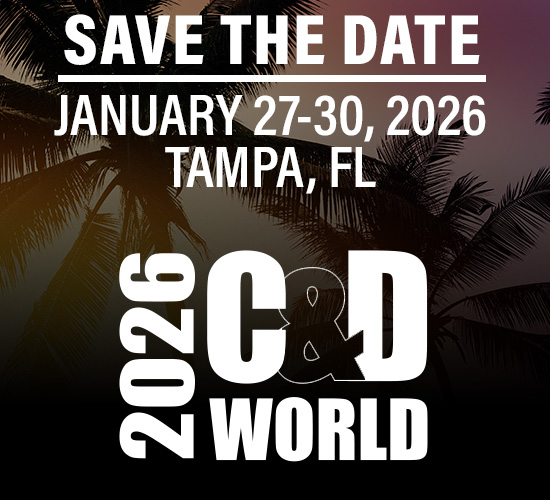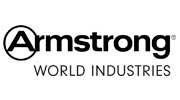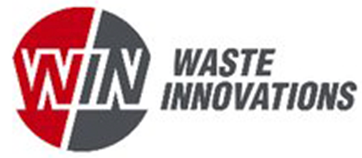Additional Resources for Recycling ConcreteTrade AssociationsThe Construction & Demolition Recycling Association (CDRA) is the only association devoted exclusively to the needs of the rapidly expanding North American construction & demolition debris processing and recycling industry. A CDRA document of specific interest to concrete recyclers is the 2012 white paper, “Recycled Concrete Aggregate: A Sustainable Choice for Unbound Base,” which was compiled by Cecil Jones, president, Diversified Engineering Services and retired chief materials engineer for North Carolina’s DOT. In December 2014, the association published a white paper on the environmental and economic impact of the C&D recycling industry. The paper, “The Benefits of Construction and Demolition Materials Recycling in the United States,” was assembled by a research team led by Dr. Timothy Townsend of the University of Florida. As with all CDRA white papers, these documents are available free of charge as a member benefit to those who belong to the Construction & Demolition Recycling Association. White papers are available to non-CDRA members for a fee of $500. Please contact [email protected] for more information. The U.S. Green Building Council is the nation’s foremost coalition of leaders from across the building industry working to promote buildings that are environmentally responsible, profitable and healthy places to live and work. The LEED (Leadership in Energy and Environmental Design) Green Building Rating System is a voluntary national standard in which construction and renovation projects earn credits toward certification as sustainable buildings. USGBC’s members developed and continue to refine LEED. ACPA – The American Concrete Pavement Association represents concrete pavement contractors, cement companies, equipment and material manufacturers and suppliers. Their mission is to make portland cement concrete the material of choice for airport, highway, industrial, street and local road pavements. Founded in 1916, the Portland Cement Association represents cement companies in the United States and Canada. It conducts market development, engineering, research, education, and public affairs programs. Download: An Engineer’s Guide to Building Green With Concrete https://www.cement.org/learn/concrete-technology/concrete-design-production/recycled-aggregates The PCA (Portland Cement Association) Concrete Technology: Recycled Aggregates page. The Innovative Pavement Research Foundation (IPRF) is a 501(c) (3) corporation, jointly sponsored by the American Concrete Pavement Association and Portland Cement Association. Beyond Roads, which is sponsored by the Asphalt Education Partnership (AEP), is a resource for information on the asphalt industry, its operations, its products and issues. The Asphalt Recycling & Reclaiming Association is an international non-profit trade association of contractors, equipment manufacturers, suppliers, public officials, and engineers engaged in the recycling and reclaiming of asphalt. NSSGA is the National Stone, Sand and Gravel Association. On Feb. 12, 2001, the merged National Stone Association and National Aggregates Association became the NSSGA. The association represents the crushed stone, sand and gravel-or aggregates-industries. The American Road & Transportation Builders Association (ARTBA) is the U.S. transportation construction industry's representative in Washington, D.C. Its mission: advocating strong federal investment in the nation's transportation infrastructure to meet public demand for a safe and efficient business transportation network. The Associated General Contractors of America (AGC) is the nation's largest and oldest construction trade association, established in 1918 after a request by President Woodrow Wilson. Wilson recognized the construction industry's national importance and desired a partner with which the government could discuss and plan for the advancement of the nation. AGC has been fulfilling that mission for the last 85 years. Founded in 1904, the American Concrete Institute (ACI) has produced more than 400 technical documents, reports, guides, specifications, and codes for the best use of concrete; conducts about 125 educational seminars each year; and has 13 different certification programs for concrete practitioners, as well as a scholarship program to promote careers in the industry. The American Coal Ash Association (ACAA) is a not-for-profit organization that promotes the beneficial use of coal combustion products (CCPs). The American Forest and Paper Association is a trade association for wood, paper and wood products. The National Ready Mixed Concrete Association supports continued expansion and improvement of the ready mixed concrete industry through leadership, advocacy, professional development, promotion and partnering. The American Society of Concrete Contractors was formed by and for concrete contractors and others who provide services and goods to the industry. The Associated Builders and Contractors (ABC) association represents 23,000 merit shop construction and construction-related firms in 79 chapters across the United States. The Strategic Development Council (SDC) brings together the concrete industry, along with government, academia, and customers, to focus on collaborative problem-solving in meaningful technology advancement. Government Agencies
Educational InstitutionsThe Recycled Materials Resource Center (RMRC) is a national center created to promote the wise use of recycled materials (pavements, secondary, waste, byproduct materials) in the highway environment. The Center is a partnership with the Federal Highway Administration (FHWA). The School of Sustainable Engineering and the Built Environment (SSEBE) at Arizona State University’s Ira A. Fulton Schools of Engineering studies technologies for implementation in the construction industry and promotes international relationships. ASU also offers ASU online, an online construction management program that can be used for distance learning. The International Center for Aggregates Research (ICAR) is a joint operation of The University of Texas at Austin and Texas A&M University. ICAR’s goal is finding the most efficient and effective use of the aggregates industry’s resources through research, education, and information exchange. The National Center for Asphalt Technology (NCAT) at Auburn University NCAT’s mission: Improve HMA performance through research, education, and information services. The World Center for Concrete Technology (WCCT) offers training, educational research and conferences for the concrete products industries.
Other OrganizationsThe American Council for Construction Education (ACCE) accredits construction education programs in colleges and universities that request its evaluation and meet its standards and criteria. The American Association of State Highway and Transportation Officials advocates transportation-related policies and provides technical services to support states in their efforts to efficiently and safely move people and goods. Since 1948, the International Road Federation (IRF) has been active in the advocacy of all issues relevant to the road industry, from financing to technology and from development to safety. Greener Buildings provides an overview of the world of greener buildings, including the latest findings on the bottom-line payoffs. The Foundation for Pavement Preservation (FP2) is a non-profit organization supported by the pavement preservation industry; contractors, material suppliers, equipment manufacturers, consulting engineers, and academia. RecyclingMarkets.net provides access to North America's Most Comprehensive searchable database of more than 17,000 companies involved in the Recycling Process throughout the USA and Canada. The Iberoamerican Federation of Ready Mixed Concrete (FIHP) is a non-profit organization that gathers the national associations and companies from the Ibero-american countries which may use ready mixed concrete. ECOBA represents its members in different regulatory bodies and work together with European Commission directorates, European Union standardization committees, International Treaty Organizations, National standardization committees, and research institutes. AggRegain is a free sustainable aggregates information service provided by the WRAP Aggregates Programme. Australian EPA development of waste and resource recovery guidelines.
ResearchThis Dutch research is on the sustainable management and use of recycled aggregates. Within the scope of this study, different concrete mixtures were manufactured to determine the influence of aggregate derived from recycled mineral building material referring to stress-strain relation of concrete. This research reviews the influence of recycled aggregate on the stress-strain relation of concrete. The Transportation Research Board’s (TRB) Research in Progress (RiP) website contains the RiP database which contains over 7,800 transportation research projects. The RiP database allows users in State DOT to add, modify and delete information on their current research projects. The use of demolished concrete as aggregate in the production of fresh concrete was investigated by the Department of Civil Engineering at the University of Strathclyde in Glasgow together with partners at La Sapienza in Rome and the Italian contractors Mabbo Appunto and Pescara. Australia Advances Series Eight on recycled concrete by Kwesi Sagoe-Crentsi CSIRO Manufacturing and Infrastructure Technology.
LiteratureIf you have any suggestions to add to these resources, please contact the CDRA at [email protected]. Books and Manuals Liu, Tony and Meyer, Christian RILEM Publications Kosmatka, S.H., Kerkhoff, B., and Panarese, W.C. The Basic Asphalt Recycling Manual (BARM) Portland Cement Association (PCA) Library Bibliographies Reports and Journals Alan D. Buck, “Recycled Concrete as a Source of Aggregate”, ACI Journal, American Concrete Institute, Detroit, May 1977. A.A. Di Maio, C.J. Zega, and L. P. Traversa, “Estimation of Compressive Strength of Recycled Concrete with the Ultrasonic Method”, Journal of ASTM International, Vol. 2, No. 5, May 2005. Fergus, J.S. “The Effect of Mix Design on the Design of Pavement Structures When Utilizing Recycled Portland Cement Concrete as Aggregate”, Ph.D. Thesis, Department of Civil Engineering, Michigan State University, l980. FHWA, “Recycled Concrete: A Valuable Transportation Resource”, 2005, www.fhwa.dot.gov/publications/focus/05apr/03.cfm FHWA, “Recycled Concrete Aggregate”, FHWA National Review, 2004, www.fhwa.dot.gov/pavement/recycling/rca.cfm Forster, S. W. “Recycled Concrete as Aggregate”, Concrete International, American Concrete Institute, Michigan, October l986. Hansen, T.C., and Boegh, E., “Elasticity and Drying Shrinkage of Recycled-Aggregate Concrete”, ACI Journal, Volume 82. No. 5, September-October, 1985. T.C. Hansen, “Mechanical Properties of Recycled Aggregate Concrete” T.C. Hansen, Recycling of Demolished Concrete and Masonry Information on Recycled Concrete Aggregate from the Recycled Materials Resource Center, University of Wisconsin. B. Juric, L. Hanzic, R. Ilic, N. Samec, “Utilization of Municipal Solid Waste Bottom Ash and Recycled Aggregate in Concrete,” Waste Management (2005)1-7. Katz, A., “Treatments for the Improvement of Recycled Aggregate” American Society of Civil Engineers, Vol. 16, No. 6, November/December, 2004. Kikuchi, M., and Mukai, T., “A Study on the Properties of Recycled Aggregate and Recycled Aggregate Concrete,” Canadian Aeronautics and Space Journal, No. 31, l983. Lee, S., Moon, H., Swamy, R., Kim, S. and Kim, J., “Sulfate Attack of Mortars Containing Recycled Fine Aggregates”, ACI Materials Journal, Vol. 102, No. 4, July-August, 2005. Salomon M. Levy, Paulo Helene, “Durability of Recycled Aggregates Concrete: A Safe Way to Sustainable Development” Cement and Concrete Research 34 (2004) 1975-1980. Li, X., Gress, D., “Mitigating alkali silica reaction in concrete containing recycled concrete aggregate”, Transportation Research Record, Vol. 1979, pp. 30-35, 2006. Meininger, Rick, Personal Communications, August 2005. Mukai, T., Kemi, T., Nakagawa, M. and Kikuchi, M. “Study of Reuse of Waste Concrete for Aggregate of Concrete,” Proceeding of the Seminar on Energy and Resources Conservation in Concrete Technology, Japan-US Cooperative Science Program, San Francisco, CA, 1979. F.T. Olorunsogo, N. Padayachee, “Performance of Recycled Aggregate Concrete Monitored by Durability Indexes” Cement and Concrete Research 32 (2002) 179-185. Otsuki, N., Miyazato, S., and Yodsudjai, W., “Influence of Recycled Aggregate on Interfacial Transition Zone, Strength, Chloride Penetration and Carbonation of Concrete”, Journal of Materials in Civil Engineering, Vol. 15, No. 5, pp. 443-451, September-October, 2003. C. Park, J. Sim, “Fundamental Properties of Concrete Using Recycled Concrete Aggregate Produced Through Advanced Recycling Progress,” TRB 2006, 13p, #06-0810. Khaldoun Rahal, “Mechanical Properties of Concrete with Recycled Coarse Aggregate” Building Environment (2005) 1-8 K. Ramamurthy, K.S. Gumaste, “Properties of Recycled Aggregate Concrete”, Indian Concrete Journal, 72:11, 49-53, 1998. Rasheeduzzafar, A. K., and A. Khan, “Recycled Concrete- A Source of New Aggregate,” Journal of the American Society of Testing Materials, Cement, Concrete and Aggregate, Vol. 6, No. 1, 1984. Download: Ready Mixed Concrete Industry LEED Reference Guide Update, August 2017 "Recycling Concrete Pavement," Concrete Paving Technology, TB-014P Recycling Portland Cement Concrete, DP-47-85 Removal and Reuse of Hardened Concrete, ACI Committee 555R-04 Report, American Concrete Institute, Michigan, 2004. D. Sani, G. Moriconji, G. Fava, V. Corinaldesi, “Leachingand Mechanical Behavior of Concrete Manufactured with Recycled Aggregates” Waste Management 25 (2005) 177-182. Scott, H.C., and Gress, D.L. “Mitigating ASR in Recycled Concrete”, ACI SP-219-5, American Concrete Institute, Vol. 219, March 1, 2004. Shayan, A. and Xu, A. “Performance and Properties of Structural Concrete Made with Recycled Concrete Aggregate”, ACI Materials Journal, Vol. 100, No. 5, September-October, 2003. Snyder, M., “Physical and Mechanical Properties of Recycled PCC Aggregate Concrete” Interim Report-Task A, DTFH61-93C-00133, U.S. Department of Transportation, Federal Highway Administration, June 1994. Sri Ravindrarajah, R., and C.T. Tam, “Properties of Concrete Made with Crushed Concrete as Coarse Aggregate,” Magazine of Concrete Research, Volume 37, No. 130, Cement and Concrete Association, March 1985. Sri Ravindrarajah, R., and C.T. Tam, “Recycling Concrete as Fine Aggregate in Concrete” International Journal of Cement Composites and Lightweight Concrete, Volume 9, No. 4, November 1987. David Stark, The Use of Recycled-Concrete Aggregate from Concrete Exhibiting-Silica Reactivity, Research and Development Bulletin RD114, Stark, D., “The Use of Recycled –Concrete Aggregate from Concrete Exhibiting Alkali-Silica Reactivity”, PCA Research and Development Bulletin RD114, Skokie, Illinois, Portland Cement Association 1996. Vivian Tam, X.F. Gao, C.M. Tam, “Microstructural Analysis of Recycled Aggregate Concrete Produced from Two-Stage Mixing Approach” Cement and Concrete Research 35 (2005) 1995-1203. Mostafa Tavakoli, Parviz Soroushian, “Drying Shrinkage Behavior of Recycled Aggregate Concrete,” Concrete International, p. 58-61 Nov. 1996 Tavakoli, M., Soroushian, P., “Strengths of Recycled Aggregate Concrete made using Field-demolished Concrete as Aggregate”, ACI Materials Journal. Vol. 93, No. 2, pp. 182-190. l996. Technical Advisory, “Use of Recycled Concrete Pavement for Aggregate in Hydraulic Cement Concrete Pavement,” T 5040.37, July, 2007 http://www.fhwa.dot.gov/pavement/t504037.cfm Download: Transportation Applications of Recycled Concrete Aggregate, FHWA State of the Practice National Review, Sept. 2004 William Turley, "What Does it Cost to Recycle Concrete & Asphalt" Use of Recycled Materials – Final Report of RILEM TC 198-URM, edited by Ch. F. Hendriks, G.M.T. Janssen and E. Vazquez, pp. 41-43, www.rilem.net/gene/main.php?base=500219&id_publication=94. M. C. Won, Use of Crushed Concrete as Aggregate for Pavement Concrete, Jianzhurang Xiao, Jiabin Li, Ch. Zhang, “Mechanical Properties of Recycled Aggregate Concrete Under Uniaxial Loading, “Cement and Concrete Research 35(2005) 1187-1194. Yrjanson, W. A., Recycling of Portland Cement Concrete Pavements, NCHRP Synthesis 154, National Cooperative Highway Research Program, Transportation Research Board, Washington, DC, 1989. Tsung-Yeuh Tu, Yuen-Yuen Chen, Chao-Lung Hwang, “Properties of HPC with Recycled Aggregates”, Cement and Concrete Research, Vol. 36, No 5, pp. 943-950, May 2006. Roumiana Zaharieva, Francois Buyle-Bodin, Eric Wirquin, “Frost Resistance of Recycled Aggregate Concrete” Cement and Concrete Research 34 (2004) 1928-1932. FHWA Report: "The Use of Recycled Materials in Highway Construction" User Guidelines for Waste and Byproduct Materials in Pavement Construction Pavement Recycling Guidelines for State and Local Governments Transportation Applications of Recycled Concrete Aggregate ICAR Publications (International Center for Aggregate Recycling) Research Report ICAR 101-1 Research Report ICAR 101-2F Research Report ICAR 102-1F ICAR 103: Use of High Fines Concrete (HFC) in Insulated Concrete Form (ICF) Construction ICAR 104: Guidelines for Proportioning Optimized Concrete Mixtures with High Microfines ICAR 104-1F: The Effects of Aggregates Characteristics on the Performance of Portland Cement Concrete ICAR 105-1: Summary of Concrete Workability Test Methods ICAR 105-2: Qualification of Concrete Workability by Means of the Vibrating Slope Apparatus ICAR 105-3F: Development of a Portable Rheometer for Fresh Portland Cement Concrete In this 201 series you will find the following reports: ICAR 201 Series: Superpave Aggregate Specifications 201-1, “Evaluation of Superpave Fine Aggregate Angularity Specification,” Arif Chowdhury, Joe Button, Vipin Kohle and David Jahn. 201-2, “Effects of Superpave Restricted Zone on Permanent Deformation,” Arif Chowdhury, Joe Button, and Jose Grau. 201-3F, “Effects of Aggregate Gradation and Angularity on VMA and Rutting Resistance,” Dae-Wook Park, Arif Chowdhury, and Joe Button. Research Report ICAR 203-1 Research Report ICAR 301-1F In this 501 series you will find the following reports: ICAR 501 Series: Increased Single-Lift Thicknesses for Aggregate Base Courses 501-2, “A Study on the Feasibility of Compacting Unbound Graded Aggregate Base Courses in Thicker Lifts than Presently Allowed by State Departments of Transportation,” Jaime L. Bueno, Kenneth H. Stokoe, II, and John J. Allen 501-3, “Prediction of Working Load Displacements Under Plate Loading Tests from Seismic Stiffness Measurements,” Michael L. Myers, Kenneth H. Stokoe, II, and John J. Allen 501-5F, “Increased Single-Lift Thicknesses for Unbound Aggregate Base Courses,” John J. Allen , Jaime L. Bueno, Michael E. Kalinski, Michael L. Myers, and Kenneth H. Stokoe, II Reports 501-1 and 501- 4 were internal documentation only and were not published. ICAR 502 Series: Structural Considerations of Unbound Aggregate Layers for Mechanistic Design In this 502 series are the following reports: 502-1, “Structural Characteristics of Unbound Aggregate Bases to meet AASHTO 2002 Design Requirements: Interim Report,” Alex Adu-Osei, Dallas Little and Robert Lytton 502-2, “Field Validation of the cross-Anisotropic Behavior of Unbound Aggregate Bases,” Erol Tutumluer, Alex Adu-Osi, Dallas Little and Robert Lytton 502-3, “Characterization of Unbound Granular Layers in Flexible Pavements,” Alex Adu-Osei ICAR 503 Series: Rapid Test to Establish Grading of Unbound Aggregates In this 503 series are the following reports: 503-1, “Evaluation of Potential Aggregate Grading Technologies,” Alan F. Rauch, Carl T. Hass, Hyoungkwan Kim, and Craig Browne 503-2, “An Evaluation of Automated Devices to Replace and Augment Manual Sieve Analyses in Determining Aggregate Gradation,” Alan F. Rauch, Carl T. Haas, Craig Browne, and Hyoungkwan Kim 503-3F, “Automation of Aggregate Characterization Using Laser Profiling and Digital Image Analysis,” Carl T. Haas, Alan F. Rauch, Hyoungkwan Kim, and Craig Browne Magazines |
























